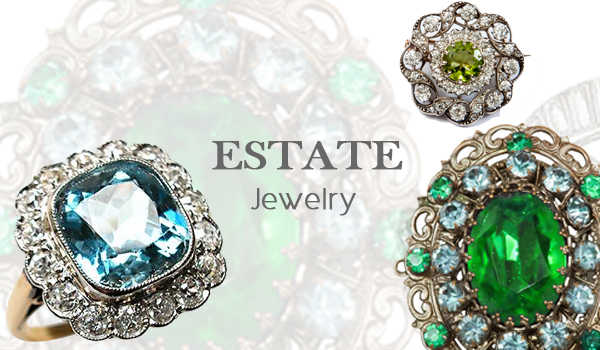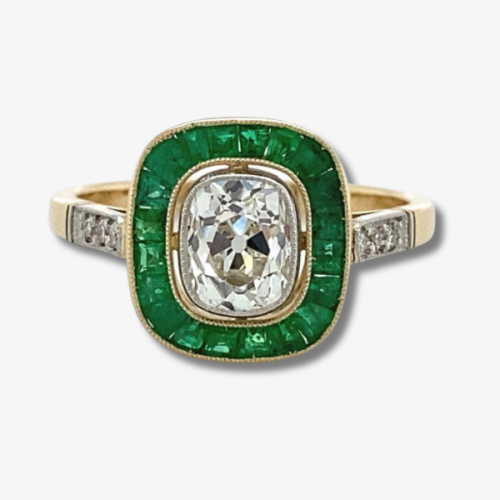Uncover the Rich History Behind Stunning Estate Fashion Jewelry Collections
The expedition of estate precious jewelry collections provides a special window right into background, disclosing the detailed relationship between craftsmanship and cultural development (estate jewelry austin). Each item is not just an accessory yet a testimony to the artistic motions and societal values of its time, from the ornate details of the Victorian era to the streamlined sophistication of the Mid-Century Modern. As we take a look at these exceptional artefacts, we discover stories that transcend generations, motivating us to consider not simply their elegance, yet the lives they have actually touched and the moments they have experienced. What keys might these collections still hold?
The Beginnings of Estate Fashion Jewelry
How did estate jewelry involved symbolize the rich background and artistry of past ages? The origins of estate jewelry can be mapped back to different periods of craftsmanship, where jewelry was not just a device however a representation of societal values, technological advancements, and imaginative expressions. Each piece narrates, typically connected with the lives of their previous proprietors, enveloping personal stories along with historical contexts.
The term "estate fashion jewelry" typically refers to secondhand items, commonly from substantial periods such as Victorian, Art Nouveau, or Art Deco. These items were created with meticulous interest to information, showcasing the ability of artisans that utilized materials like gold, silver, and valuable gems. Unlike modern jewelry, estate pieces commonly feature distinct styles that highlight the aesthetics of their time, therefore acting as substantial web links to the past.

Notable Style Ages
Throughout history, several notable design periods have actually substantially affected the advancement of estate fashion jewelry, each defined by unique styles, products, and social contexts. The Georgian era (1714-1837) marked the beginning of complex styles, frequently featuring nature-inspired concepts and making use of materials like gold, silver, and gems embeded in sophisticated settings. Following this, the Victorian era (1837-1901) presented charming themes, with nostalgic fashion jewelry and innovative methods such as the use of enamel and cameos.
The Art Nouveau duration (1890-1910) commemorated organic kinds and the charm of nature, utilizing products like opals and pearls in streaming styles. This was succeeded by the Art Deco age (1920-1939), which welcomed geometric patterns, strong colors, and lavish materials such as platinum and rubies, reflecting the modernist spirit of the time.
The Mid-Century Modern period (1940-1960) showcased streamlined layouts and using unconventional products, highlighting minimalism and performance. Each of these eras not just reflects the imaginative movements of their time yet also envelops the societal values and technical improvements that shaped jewelry design, making them a fascinating topic for chroniclers and collectors alike.

Famous Estate Fashion Jewelry Collections
The rich background of estate jewelry is magnificently exhibited by several distinguished collections that display the artistry and craftsmanship from different style periods. One of the most popular is the Cartier Collection, which mirrors the luxury and technology of the legendary French jeweler. Parts from this collection usually feature elaborate layouts and beautiful gemstones, highlighting the brand name's commitment to fine workmanship.
An additional significant collection is the Duchess of Windsor's precious jewelry collection, which makes up a number of unique pieces, consisting of the legendary "Windsor" arm band. This collection not just exhibits the elegance of the Art Deco duration yet also lugs an abundant story of love and loss, as it came from Wallis Simpson, that notoriously wed Edward VIII.
The collection of the late starlet Elizabeth Taylor likewise sticks out in the world of estate jewelry. With numerous pieces designed by renowned jewelry experts like Bulgari and Cartier, her collection personifies prestige and refinement, emphasizing her personal design and fondness for special gems.
These well-known estate fashion jewelry collections act as a testament to the long-lasting allure of fine precious jewelry, using insight into the cultural and imaginative movements that shaped their development.
The Cultural Value
Estate fashion jewelry collections hold profound social value, mirroring not just the visual values of their respective periods however likewise the historic and social contexts in which they were produced. Each item typically embodies the workmanship and artistic trends of its time, showcasing the advancement of design and technology in fashion jewelry production.
In addition, these collections work as tangible links to cultural traditions and routines. Wedding event bands and heirloom breastpins might symbolize love and familial bonds, while pieces decorated with certain gemstones can represent social or local pop over here identities. The materials used-- whether gold, silver, or priceless rocks-- frequently inform tales of profession, exploration, and the wealth accumulation of societies.
In addition, estate jewelry can function as historic artefacts, giving insights right into the lives of individuals and the social standards they browsed. The method precious jewelry was put on and valued can expose much concerning gender functions, standing, and personal expression within varying cultural landscapes. Thus, estate jewelry transcends simple decoration, working as a rich story of human experience, creativity, and cultural heritage, welcoming modern target markets to involve with the past in a purposeful way.
Caring for Your Estate Pieces
Looking after estate jewelry pieces requires a thoughtful method to ensure their durability and protect their This Site distinct attributes. To preserve the charm of these treasures, it is vital to handle them with treatment. Constantly clean estate jewelry using a soft, lint-free cloth after each wear to get rid of oils and dust. For much deeper cleaning, use a mild soap solution and a soft brush, making sure to stay clear of rough chemicals that might damage delicate products.
Storage is equally vital; store pieces separately in a fabric-lined box to avoid scratching and entangling. Think about using anti-tarnish bags or fabrics for silver items, as this assists to slow down the tarnishing i loved this procedure. Additionally, stay clear of subjecting precious jewelry to extreme moisture, severe temperature levels, or direct sunshine, which can negatively influence gemstones and steels.
Consulting a jewelry expert experienced in vintage or antique pieces can give specialized care choices. By implementing these methods, collection agencies can maintain their estate jewelry's aesthetic and historical value, making sure these items proceed to be cherished for generations to come.
Final Thought
To conclude, the expedition of estate jewelry collections reveals a tapestry of creative expression and social relevance, mirroring the worths and visual appeals of different historical periods. When had them, each piece offers as a testament to outstanding workmanship and the stories of those that. Recognizing the beginnings, design eras, and noteworthy collections improves gratitude for these artifacts, emphasizing their role in preserving cultural heritage and motivating ongoing stewardship and care for these remarkable treasures.
The exploration of estate jewelry collections offers an unique home window right into history, exposing the elaborate relationship in between workmanship and social development. The origins of estate precious jewelry can be mapped back to numerous durations of workmanship, where precious jewelry was not just an accessory but a representation of social values, technological improvements, and imaginative expressions.The term "estate jewelry" normally refers to secondhand pieces, frequently from significant periods such as Victorian, Art Nouveau, or Art Deco.The rich history of estate fashion jewelry is magnificently exemplified by a number of renowned collections that display the creativity and craftsmanship from different design periods.In final thought, the exploration of estate fashion jewelry collections reveals a tapestry of imaginative expression and cultural value, showing the worths and aesthetic appeals of different historical periods.